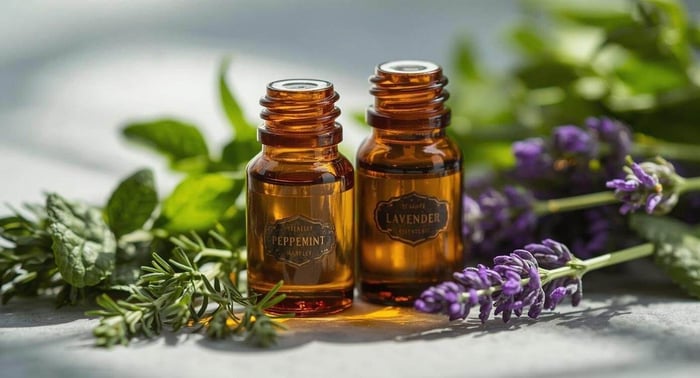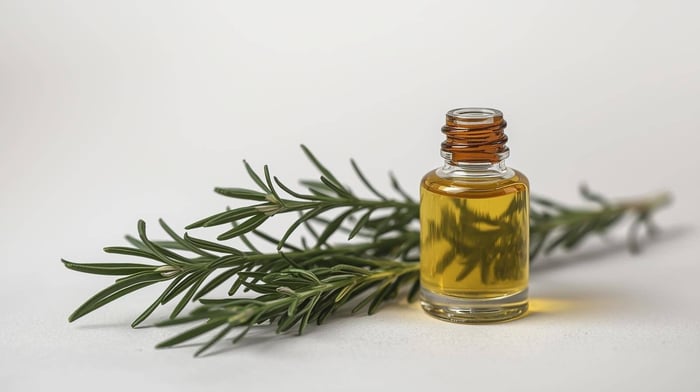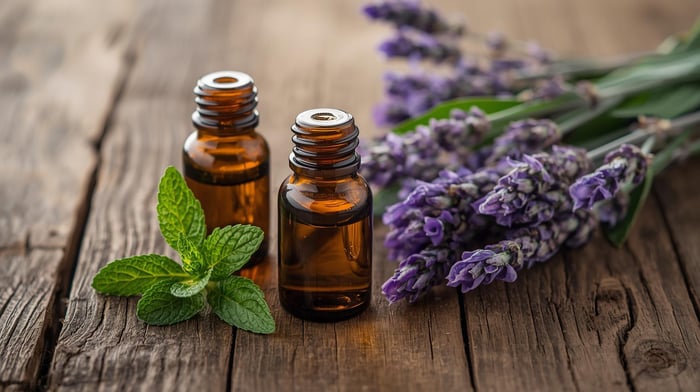Table of Contents
At a Glance
|
You may have been wondering if there are any natural ways to ease migraine that you can safely try at home. People often explore natural alternatives such as cold compresses, relaxation techniques, or small changes in diet and sleep as part of self-care. Another option that many turn to for simple relief is essential oils.
Scents such as peppermint or lavender can create a cooling or calming sensation when a migraine starts to build. While experiences vary from person to person, such aromas are part of the reason lavender and peppermint are often cited as the best essential oil for migraine.
In this guide, we’ll look at the most commonly used oils for migraine support, how they may bring comfort, and practical ways to make them part of your routine.
How Essential Oils May Support Migraine

Essential oils are often thought of as a gentle form of support rather than a primary approach. They may help with comfort during the early stages of a migraine, especially when included as part of your wider self-care plan.
Calming the nervous system
Aromas such as lavender have been studied for their relaxing properties, with some small clinical trials suggesting that inhaling lavender oil may reduce headache severity for certain individuals (Sasannejad et al., 2012). Even though the research is limited, many people notice that calming scents help them feel less tense and make stressful moments easier to manage.
Creating sensory relief
Some oils, like peppermint, contain compounds that can create a cooling sensation on the skin or release a refreshing aroma. For some people, these shifts in sensation may help distract from discomfort and make their environment feel easier to manage. Small clinical studies have suggested benefits for tension-type headaches, which is why peppermint is often considered one of the best essential oils for headache.
Supporting rest and balance
Scents can act as cues that prepare your body for rest. Using oils in the evening may help you unwind more easily and support better sleep quality. Since disrupted sleep is a known migraine trigger, adding essential oils to your bedtime rituals may provide indirect benefits.
Best Essential Oils for Migraines
Peppermint Oil
Peppermint oil is one of the most widely discussed oils for headache and migraine support. Its key compound, menthol, creates a cooling sensation that many people find refreshing on the skin and soothing to breathe in. This effect may help take the edge off when sensitivity or discomfort starts to rise.
Researchers believe part of this action comes from the way menthol activates TRPM8 receptors, the same ‘cold’ receptors stimulated by ice packs. Activation of these pathways can produce direct analgesic effects, which helps explain why cooling oils are often associated with relief.

Research on peppermint oil has mainly looked at its effects in tension-type headache:
A 1996 trial found that peppermint oil solution applied to the temples was reported to reduce pain in people with tension-type headaches, with effects comparable to paracetamol (Göbel et al., 1996).
Reviews, such as Kligler & Chaudhary (2007), primarily focused on peppermint oil for digestive concerns but also note its use in headache, though most evidence is still small-scale.
More recent research has continued to suggest benefits for tension-type headache, especially topical menthol preparations applied to the forehead and temples (Göbel et al., 2016).
A migraine-specific trial also found that a 10% menthol solution applied to the forehead and temples reduced pain and other symptoms compared with placebo, though findings remain preliminary (Borhani Haghighi et al., 2010).
While migraine is more complex than tension-type headache, this body of evidence is why peppermint oil is often considered a helpful option. Inhalation and diluted topical use are the approaches people most often try.
Lavender Oil
Lavender oil is another essential oil often discussed for migraine support, mainly because of its calming properties. Its floral scent is commonly linked with relaxation and stress relief, and some people find that inhaling lavender helps them settle during an attack.
A small study tested lavender oil inhalation during migraine episodes and found that participants reported a reduction in headache severity compared with placebo (Sasannejad et al., 2012). While limited, it remains one of the few clinical trials to directly examine lavender oil in the context of migraine.
Reviews in complementary and alternative medicine have described lavender as one of the more promising oils for headache and migraine, but be aware that research is still limited and further studies are needed (Murtey et al., 2023; Koulivand et al., 2013; Yuan et al., 2021).
Inhalation is the most common way lavender oil is used. You may want to try this method with a diffuser or by placing a few drops on a tissue to breathe in the scent. Diluted topical use is also possible, but inhalation remains the most widely used approach.
Eucalyptus Oil
Eucalyptus oil is known for its sharp, clearing aroma, and many find it helpful for easier breathing and for the sense of freshness it brings. For those with migraine, especially when sinus pressure or congestion is also present, using eucalyptus may offer gentle relief.
Direct research on eucalyptus oil and migraine is limited, but there have been a few small studies related to its use in other types of pain. For example, one clinical trial found that inhaling eucalyptus oil reduced pain scores and supported relaxation in people recovering from knee surgery (Jun et al., 2013). While not migraine-specific, findings like these are part of why eucalyptus sometimes appears in discussions of essential oils for headache.
Eucalyptus oil is most often tried through inhalation, either in steam, through a diffuser, or by adding a drop to hot water and breathing in the vapor. Some people also use diluted topical blends, but inhalation tends to be the more common approach.
Rosemary Oil
Rosemary oil is often linked with stimulation and mental clarity, with many describing its fresh, herbal scent as invigorating. For people with migraine, especially when fatigue or difficulty concentrating are present, this kind of sensory lift may feel supportive.

Direct research on rosemary oil in migraine is very limited. Much of the available evidence comes from its broader traditional use for pain or circulation. Compounds in rosemary, including rosmarinic acid and cineole, have been associated with analgesic and muscle relaxant properties in experimental models (Al-Sereiti et al., 1999). Some early reviews also suggest rosemary extracts may influence pain pathways and relaxation, though findings are not migraine-specific (Yuan et al., 2021). While these results are preliminary, they help explain why rosemary oil is sometimes mentioned in discussions of headache support.
Many people try rosemary oil by inhalation, either diffused into the air or by adding a few drops to hot water and breathing in the vapor. Some also apply it in diluted topical form, though inhalation remains the most used method.
Chamomile Oil
Chamomile is often associated with calm and relaxation, with its soft, floral aroma widely used in herbal teas, oils, and bathing products. For those with migraine, especially when stress or difficulty sleeping are triggers, chamomile oil may provide a gentle, supportive option.
Direct research into the use of chamomile essential oil in migraine is limited. That said, chamomile has been examined for its calming and anti-inflammatory properties in both traditional and modern contexts. Some small studies, along with its long history of use as an herbal remedy, suggest that chamomile preparations may help reduce anxiety, support sleep, and ease pain perception (McKay & Blumberg, 2006; Srivastava et al., 2010). While these findings are not migraine-specific, they help explain why chamomile oil is sometimes included when people explore essential oils for managing headaches.
The most common way this oil is used is through inhalation, often with a diffuser or by adding a few drops to warm water and breathing in the vapor. You may also consider diluted topical applications.
How to Use Essential Oils Safely
Essential oils are highly concentrated, so a little goes a long way. Most people use them by inhalation, whether through a diffuser, steam inhalation, or simply placing a few drops on a tissue. This tends to be the safest and most common method.
Topical use is also possible, but oils should always be diluted in a carrier oil before being applied to the skin. Undiluted oils can cause irritation, especially on sensitive areas. A patch test on a small area is a good idea if you are trying out an essential oil for migraine for the first time.
Do not ingest essential oils. Avoid contact with the eyes and mucous membranes.
Children, pregnant women, and those with allergies or asthma may be more sensitive to essential oils. If you fall into one of these groups, it’s especially important to start with very small amounts, watch closely for any reaction, and stop use if you notice irritation or discomfort. During pregnancy or for young children, many people choose to avoid essential oils altogether or seek professional guidance before use.
If scents make your migraine feel worse (osmophobia), skip aromatherapy during an attack and focus on other comfort measures that suit you better.
Essential Oils and General Headaches
While much of the focus here has been on migraine, some essential oils are also used more generally for other types of headaches. Peppermint is often mentioned for tension-type headaches, especially when applied topically to the temples. Eucalyptus may feel useful when sinus pressure or congestion adds to discomfort.
These uses are usually part of everyday wellbeing routines rather than formal treatment. In this way, essential oils are one of several natural options people may try alongside habits like rest, hydration, and stress management.
Everyday Wellbeing with Oils
When considering the best essential oils for migraines, it helps to think about how they fit into your everyday routine. Their scents can bring a sense of comfort to moments like preparing for sleep or taking a calm pause to reset when things feel tense.
In this way, essential oils may play a small role alongside other natural migraine strategies, such as ensuring a steady sleep schedule, light daily movement, and making thoughtful food choices that support overall balance, or exploring approaches like homeopathic remedies for migraines.
Some people also use gentle aromatherapy massage with diluted blends as part of their self-care routine, with small studies suggesting it may add comfort and improve quality of life in people with recurrent headaches (Kuriyama et al., 2005; Öntürk Akyüz et al., 2024). Taken together, these habits can help create a more stable routine where migraines may feel easier to manage.
Brain Ritual® — A Nutritional Approach to Migraine
If you’ve been exploring natural options like essential oils for comfort, then you may also be interested in a more structured nutritional approach for your migraine support. While oils can play a role in easing day-to-day routines, Brain Ritual® was developed as a medical food to address the deeper nutritional and energy needs of the brain.
How Brain Ritual® works:
Provides over 35 bioavailable nutrients in forms identical to those already used by the body, designed to support mitochondrial function and brain energy.
Includes ketone bodies as an efficient alternative fuel for the brain, alongside glucose and lactate. All of these can cross the blood–brain barrier to supply energy where it is needed most.
Addresses common nutritional gaps linked with migraine by including key vitamins, minerals, and cofactors.
Focuses on long-term support for brain stability, rather than short-term symptom relief.
Why it complements essential oils:
Essential oils can offer sensory comfort and relaxation, while Brain Ritual® targets the underlying nutritional and metabolic factors, including brain energy, that may influence migraine. Together, they can form part of a broader self-care toolkit.
Find out more and purchase Brain Ritual® here.
Disclaimer: Brain Ritual® is a medical food for the dietary management of migraine and is not intended to diagnose, treat, cure, or prevent any disease. This content is for informational and educational purposes only and is not intended as medical advice.
Common Questions
Are there any other essential oils that might play a role in migraine?
Some research suggests that plant oils beyond those already covered may play a role in migraine well-being. These include oils derived from ginger, clove, basil, fennel, coriander, and anise. They are less well studied than the more familiar options, but occasionally appear in broader discussions of natural approaches. Evidence remains very limited, so they are generally considered secondary to the better-studied oils like peppermint and lavender (Yuan et al., 2021).
How might essential oils work in migraine?
Reviews suggest that essential oils may influence processes linked with migraine such as neurogenic inflammation (irritation and swelling in nerve pathways), hyperalgesia (increased sensitivity to pain), and vasorelaxation (blood vessel relaxation). These ideas are still being explored, and more research is needed to understand their significance.
Aromatherapy for Migraine Headaches
Some people find that aromatherapy with oils like lavender or peppermint provides a sense of relaxation or sensory relief. While experiences vary and the evidence is still limited, inhaling certain aromas may bring comfort during the early stages of a migraine or when included as part of broader self-care.
Is magnesium oil an essential oil?
No, magnesium oil is not an essential oil. Essential oils are concentrated aromatic extracts from plants, while magnesium oil is a mineral solution made by dissolving magnesium chloride in water. Some people apply it to the skin with the idea that magnesium may be absorbed, but unlike essential oils, its effects are linked to mineral content rather than scent. If you’d like to learn more, see our full article on magnesium oil for migraine headaches.
What is the best essential oil for migraines?
There isn’t a single oil that works best for everyone, but peppermint and lavender are the most frequently studied and most often recommended. Others, including eucalyptus, rosemary, and chamomile, are sometimes used for specific situations, such as when sinus pressure, fatigue, or trouble sleeping are part of the picture.
Final Thoughts
Essential oils can offer gentle support for people living with migraine, particularly when used as part of a wider self-care routine. Though not a stand-alone solution, certain oils like peppermint and lavender are often highlighted for their cooling or soothing effects, and both have some preliminary scientific evidence behind them. Others, such as eucalyptus, rosemary, and chamomile, may also be worth considering depending on your individual triggers or symptoms.
When thinking about the best essential oil for migraine, it’s important to remember that no single option works for everyone. Exploring different oils safely and mindfully may help you discover whether using them adds comfort to your routine. As with any natural approach, start small and pay attention to how your body responds to new scents and sensations.




